Clinical Practice: Reflective Essay on Blood Glucose Assessment Skills
VerifiedAdded on 2022/10/09
|5
|1231
|4
Report
AI Summary
This reflective essay details a student's experience and learning in a practical class focused on blood glucose assessment for diabetic patients. The essay describes the practical exercises, the facilitator's guidance, and the student's personal feelings and growth throughout the process. The student discusses the importance of the skill, the methods used (including finger pricking and glucometer use), and the application of the ISBAR technique for handover. The essay includes an evaluation of the learning experience, analysis of the importance of blood glucose testing for diabetes management, and a conclusion emphasizing the importance of the skill for future clinical practice. The student also outlines an action plan to help clients manage their conditions, including designing workout plans and healthy eating habits, using the knowledge gained to assess the risk of diabetes, and promoting self-care practices. References to relevant studies support the student's reflections and plans.
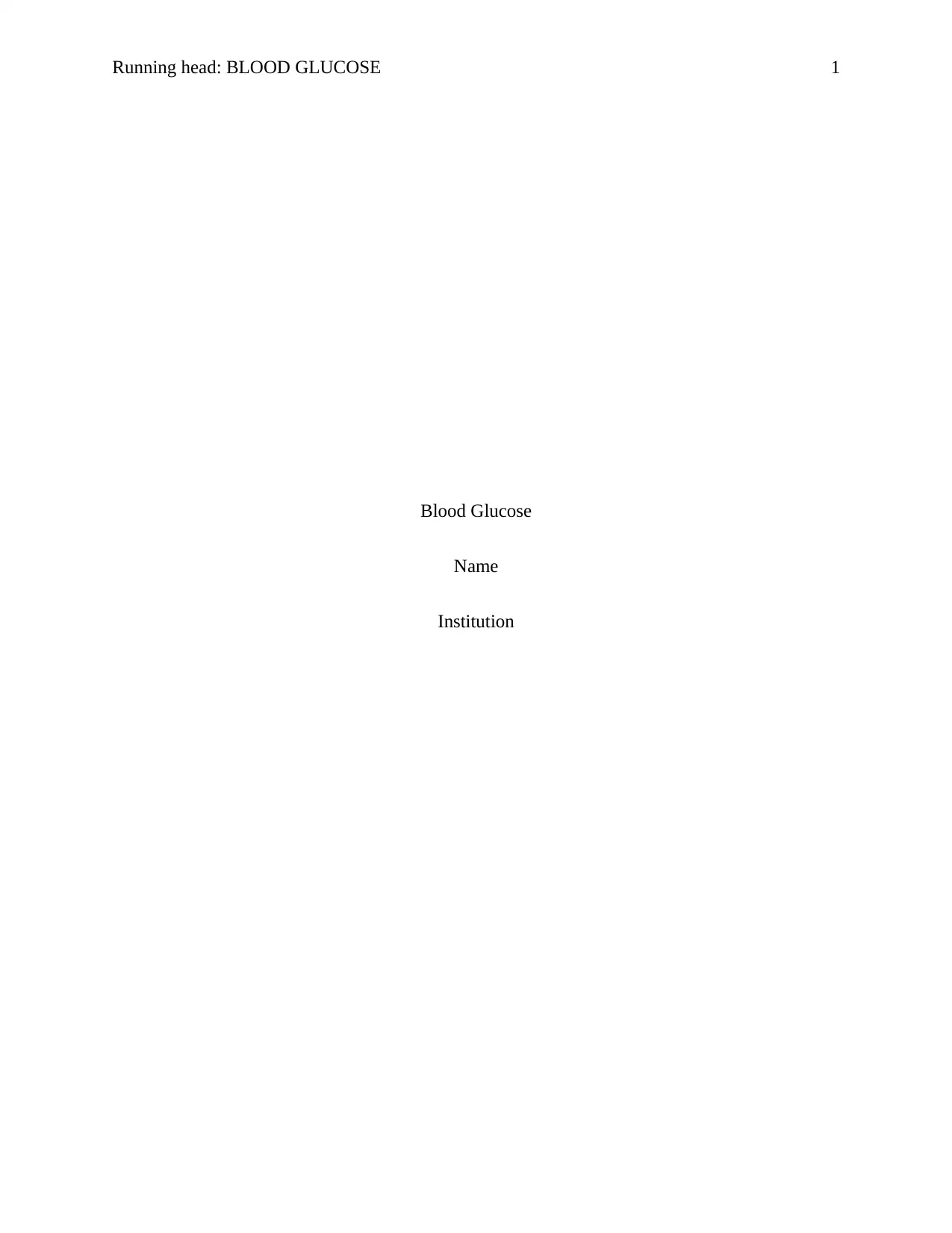
Running head: BLOOD GLUCOSE 1
Blood Glucose
Name
Institution
Blood Glucose
Name
Institution
Paraphrase This Document
Need a fresh take? Get an instant paraphrase of this document with our AI Paraphraser
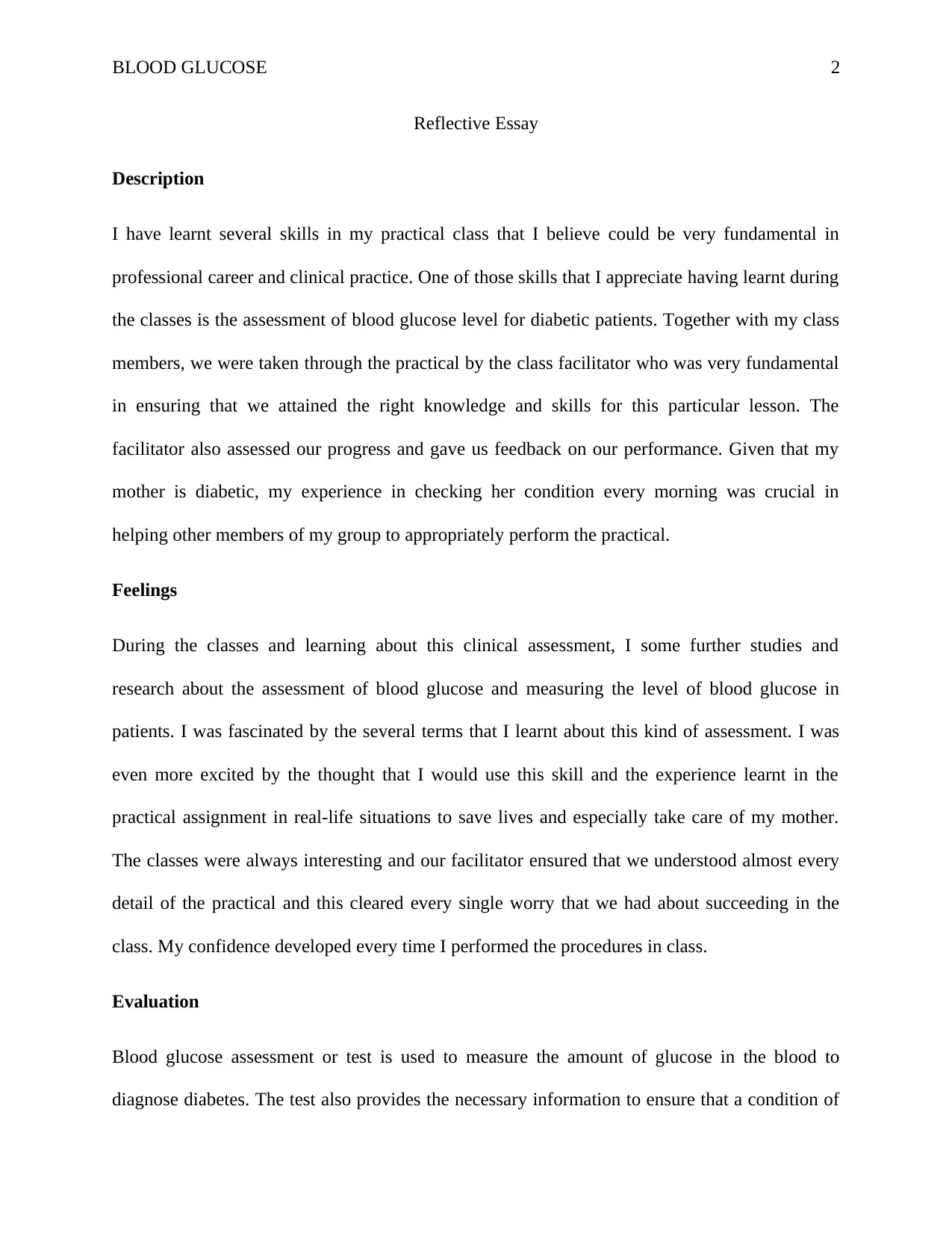
BLOOD GLUCOSE 2
Reflective Essay
Description
I have learnt several skills in my practical class that I believe could be very fundamental in
professional career and clinical practice. One of those skills that I appreciate having learnt during
the classes is the assessment of blood glucose level for diabetic patients. Together with my class
members, we were taken through the practical by the class facilitator who was very fundamental
in ensuring that we attained the right knowledge and skills for this particular lesson. The
facilitator also assessed our progress and gave us feedback on our performance. Given that my
mother is diabetic, my experience in checking her condition every morning was crucial in
helping other members of my group to appropriately perform the practical.
Feelings
During the classes and learning about this clinical assessment, I some further studies and
research about the assessment of blood glucose and measuring the level of blood glucose in
patients. I was fascinated by the several terms that I learnt about this kind of assessment. I was
even more excited by the thought that I would use this skill and the experience learnt in the
practical assignment in real-life situations to save lives and especially take care of my mother.
The classes were always interesting and our facilitator ensured that we understood almost every
detail of the practical and this cleared every single worry that we had about succeeding in the
class. My confidence developed every time I performed the procedures in class.
Evaluation
Blood glucose assessment or test is used to measure the amount of glucose in the blood to
diagnose diabetes. The test also provides the necessary information to ensure that a condition of
Reflective Essay
Description
I have learnt several skills in my practical class that I believe could be very fundamental in
professional career and clinical practice. One of those skills that I appreciate having learnt during
the classes is the assessment of blood glucose level for diabetic patients. Together with my class
members, we were taken through the practical by the class facilitator who was very fundamental
in ensuring that we attained the right knowledge and skills for this particular lesson. The
facilitator also assessed our progress and gave us feedback on our performance. Given that my
mother is diabetic, my experience in checking her condition every morning was crucial in
helping other members of my group to appropriately perform the practical.
Feelings
During the classes and learning about this clinical assessment, I some further studies and
research about the assessment of blood glucose and measuring the level of blood glucose in
patients. I was fascinated by the several terms that I learnt about this kind of assessment. I was
even more excited by the thought that I would use this skill and the experience learnt in the
practical assignment in real-life situations to save lives and especially take care of my mother.
The classes were always interesting and our facilitator ensured that we understood almost every
detail of the practical and this cleared every single worry that we had about succeeding in the
class. My confidence developed every time I performed the procedures in class.
Evaluation
Blood glucose assessment or test is used to measure the amount of glucose in the blood to
diagnose diabetes. The test also provides the necessary information to ensure that a condition of
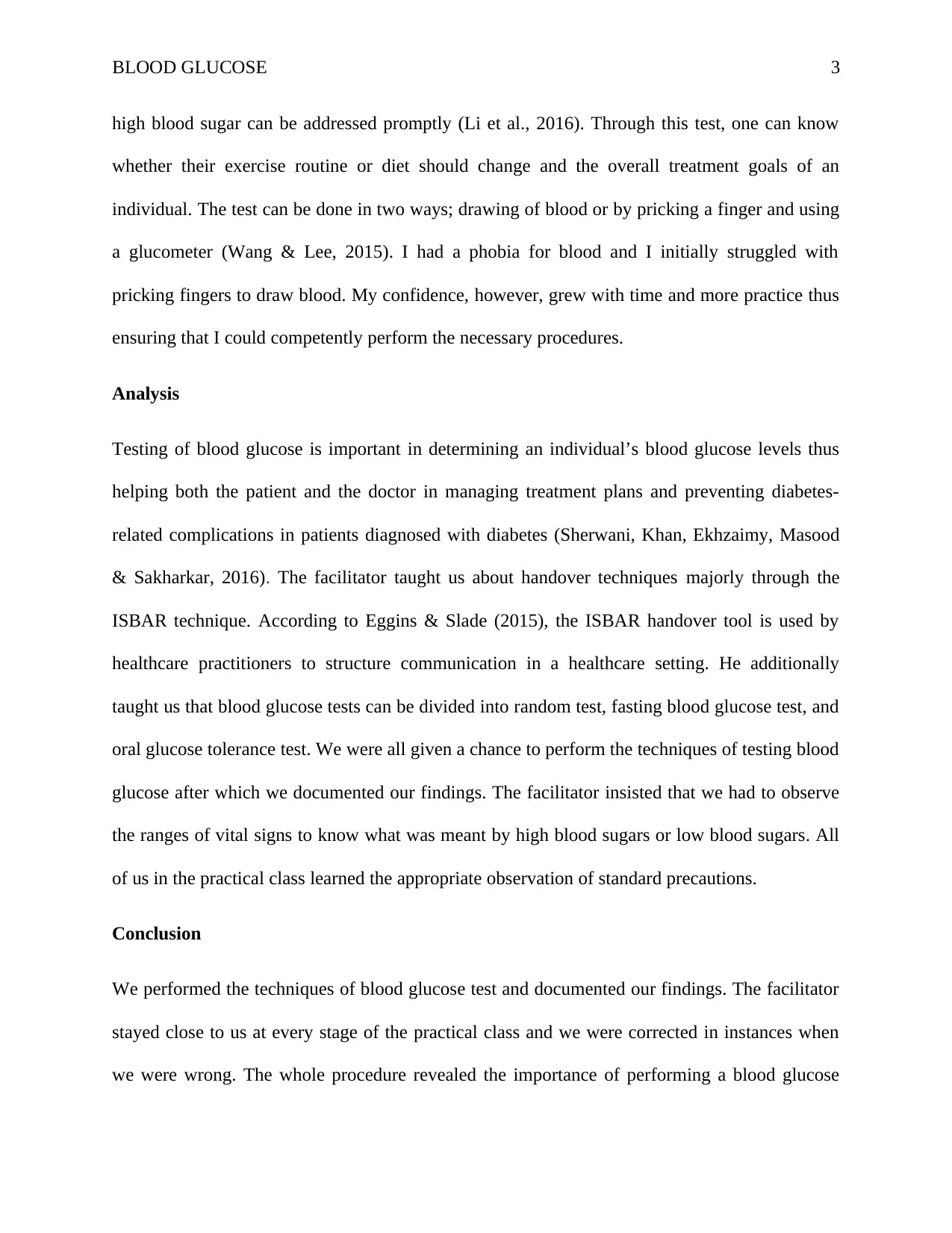
BLOOD GLUCOSE 3
high blood sugar can be addressed promptly (Li et al., 2016). Through this test, one can know
whether their exercise routine or diet should change and the overall treatment goals of an
individual. The test can be done in two ways; drawing of blood or by pricking a finger and using
a glucometer (Wang & Lee, 2015). I had a phobia for blood and I initially struggled with
pricking fingers to draw blood. My confidence, however, grew with time and more practice thus
ensuring that I could competently perform the necessary procedures.
Analysis
Testing of blood glucose is important in determining an individual’s blood glucose levels thus
helping both the patient and the doctor in managing treatment plans and preventing diabetes-
related complications in patients diagnosed with diabetes (Sherwani, Khan, Ekhzaimy, Masood
& Sakharkar, 2016). The facilitator taught us about handover techniques majorly through the
ISBAR technique. According to Eggins & Slade (2015), the ISBAR handover tool is used by
healthcare practitioners to structure communication in a healthcare setting. He additionally
taught us that blood glucose tests can be divided into random test, fasting blood glucose test, and
oral glucose tolerance test. We were all given a chance to perform the techniques of testing blood
glucose after which we documented our findings. The facilitator insisted that we had to observe
the ranges of vital signs to know what was meant by high blood sugars or low blood sugars. All
of us in the practical class learned the appropriate observation of standard precautions.
Conclusion
We performed the techniques of blood glucose test and documented our findings. The facilitator
stayed close to us at every stage of the practical class and we were corrected in instances when
we were wrong. The whole procedure revealed the importance of performing a blood glucose
high blood sugar can be addressed promptly (Li et al., 2016). Through this test, one can know
whether their exercise routine or diet should change and the overall treatment goals of an
individual. The test can be done in two ways; drawing of blood or by pricking a finger and using
a glucometer (Wang & Lee, 2015). I had a phobia for blood and I initially struggled with
pricking fingers to draw blood. My confidence, however, grew with time and more practice thus
ensuring that I could competently perform the necessary procedures.
Analysis
Testing of blood glucose is important in determining an individual’s blood glucose levels thus
helping both the patient and the doctor in managing treatment plans and preventing diabetes-
related complications in patients diagnosed with diabetes (Sherwani, Khan, Ekhzaimy, Masood
& Sakharkar, 2016). The facilitator taught us about handover techniques majorly through the
ISBAR technique. According to Eggins & Slade (2015), the ISBAR handover tool is used by
healthcare practitioners to structure communication in a healthcare setting. He additionally
taught us that blood glucose tests can be divided into random test, fasting blood glucose test, and
oral glucose tolerance test. We were all given a chance to perform the techniques of testing blood
glucose after which we documented our findings. The facilitator insisted that we had to observe
the ranges of vital signs to know what was meant by high blood sugars or low blood sugars. All
of us in the practical class learned the appropriate observation of standard precautions.
Conclusion
We performed the techniques of blood glucose test and documented our findings. The facilitator
stayed close to us at every stage of the practical class and we were corrected in instances when
we were wrong. The whole procedure revealed the importance of performing a blood glucose
⊘ This is a preview!⊘
Do you want full access?
Subscribe today to unlock all pages.

Trusted by 1+ million students worldwide
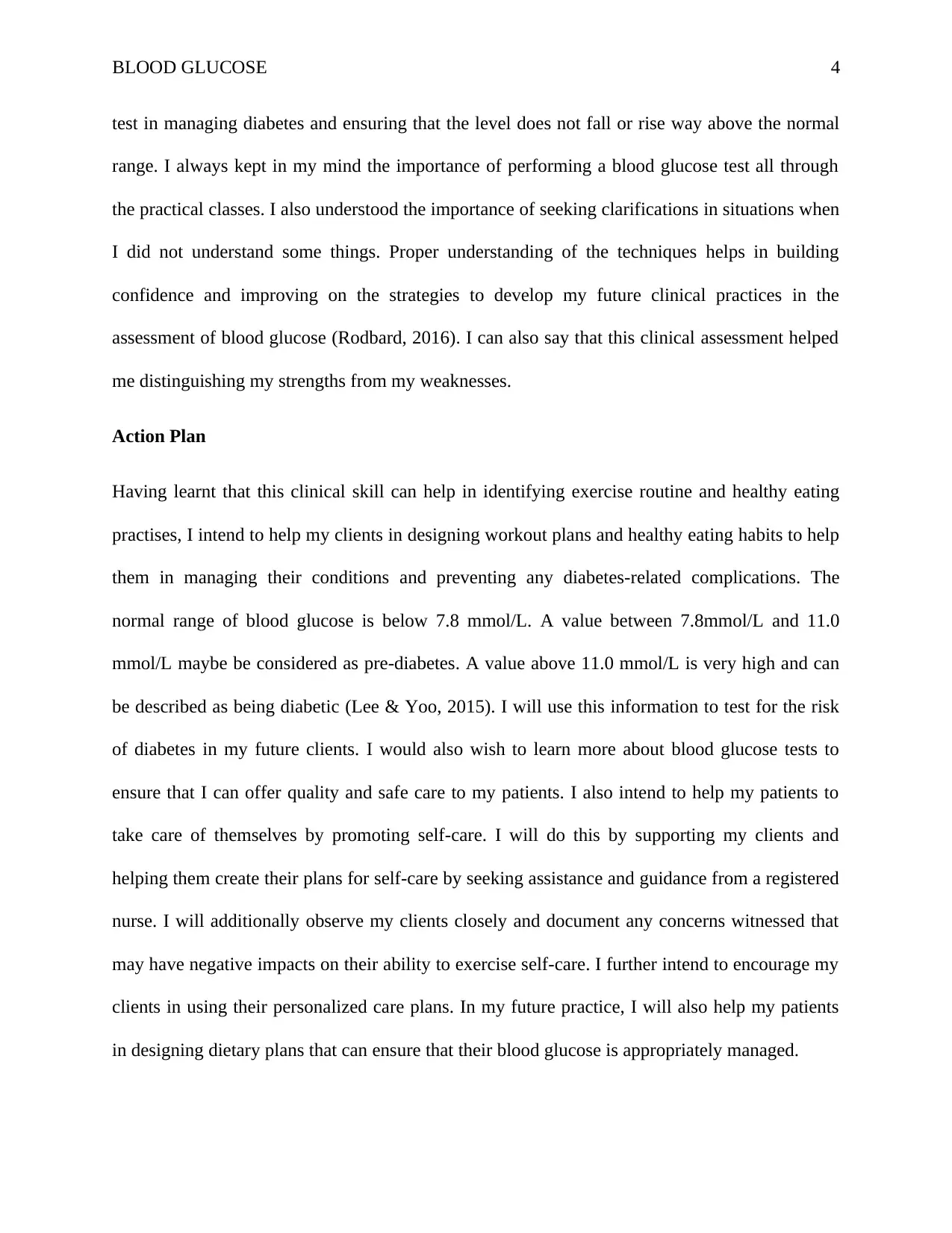
BLOOD GLUCOSE 4
test in managing diabetes and ensuring that the level does not fall or rise way above the normal
range. I always kept in my mind the importance of performing a blood glucose test all through
the practical classes. I also understood the importance of seeking clarifications in situations when
I did not understand some things. Proper understanding of the techniques helps in building
confidence and improving on the strategies to develop my future clinical practices in the
assessment of blood glucose (Rodbard, 2016). I can also say that this clinical assessment helped
me distinguishing my strengths from my weaknesses.
Action Plan
Having learnt that this clinical skill can help in identifying exercise routine and healthy eating
practises, I intend to help my clients in designing workout plans and healthy eating habits to help
them in managing their conditions and preventing any diabetes-related complications. The
normal range of blood glucose is below 7.8 mmol/L. A value between 7.8mmol/L and 11.0
mmol/L maybe be considered as pre-diabetes. A value above 11.0 mmol/L is very high and can
be described as being diabetic (Lee & Yoo, 2015). I will use this information to test for the risk
of diabetes in my future clients. I would also wish to learn more about blood glucose tests to
ensure that I can offer quality and safe care to my patients. I also intend to help my patients to
take care of themselves by promoting self-care. I will do this by supporting my clients and
helping them create their plans for self-care by seeking assistance and guidance from a registered
nurse. I will additionally observe my clients closely and document any concerns witnessed that
may have negative impacts on their ability to exercise self-care. I further intend to encourage my
clients in using their personalized care plans. In my future practice, I will also help my patients
in designing dietary plans that can ensure that their blood glucose is appropriately managed.
test in managing diabetes and ensuring that the level does not fall or rise way above the normal
range. I always kept in my mind the importance of performing a blood glucose test all through
the practical classes. I also understood the importance of seeking clarifications in situations when
I did not understand some things. Proper understanding of the techniques helps in building
confidence and improving on the strategies to develop my future clinical practices in the
assessment of blood glucose (Rodbard, 2016). I can also say that this clinical assessment helped
me distinguishing my strengths from my weaknesses.
Action Plan
Having learnt that this clinical skill can help in identifying exercise routine and healthy eating
practises, I intend to help my clients in designing workout plans and healthy eating habits to help
them in managing their conditions and preventing any diabetes-related complications. The
normal range of blood glucose is below 7.8 mmol/L. A value between 7.8mmol/L and 11.0
mmol/L maybe be considered as pre-diabetes. A value above 11.0 mmol/L is very high and can
be described as being diabetic (Lee & Yoo, 2015). I will use this information to test for the risk
of diabetes in my future clients. I would also wish to learn more about blood glucose tests to
ensure that I can offer quality and safe care to my patients. I also intend to help my patients to
take care of themselves by promoting self-care. I will do this by supporting my clients and
helping them create their plans for self-care by seeking assistance and guidance from a registered
nurse. I will additionally observe my clients closely and document any concerns witnessed that
may have negative impacts on their ability to exercise self-care. I further intend to encourage my
clients in using their personalized care plans. In my future practice, I will also help my patients
in designing dietary plans that can ensure that their blood glucose is appropriately managed.
Paraphrase This Document
Need a fresh take? Get an instant paraphrase of this document with our AI Paraphraser
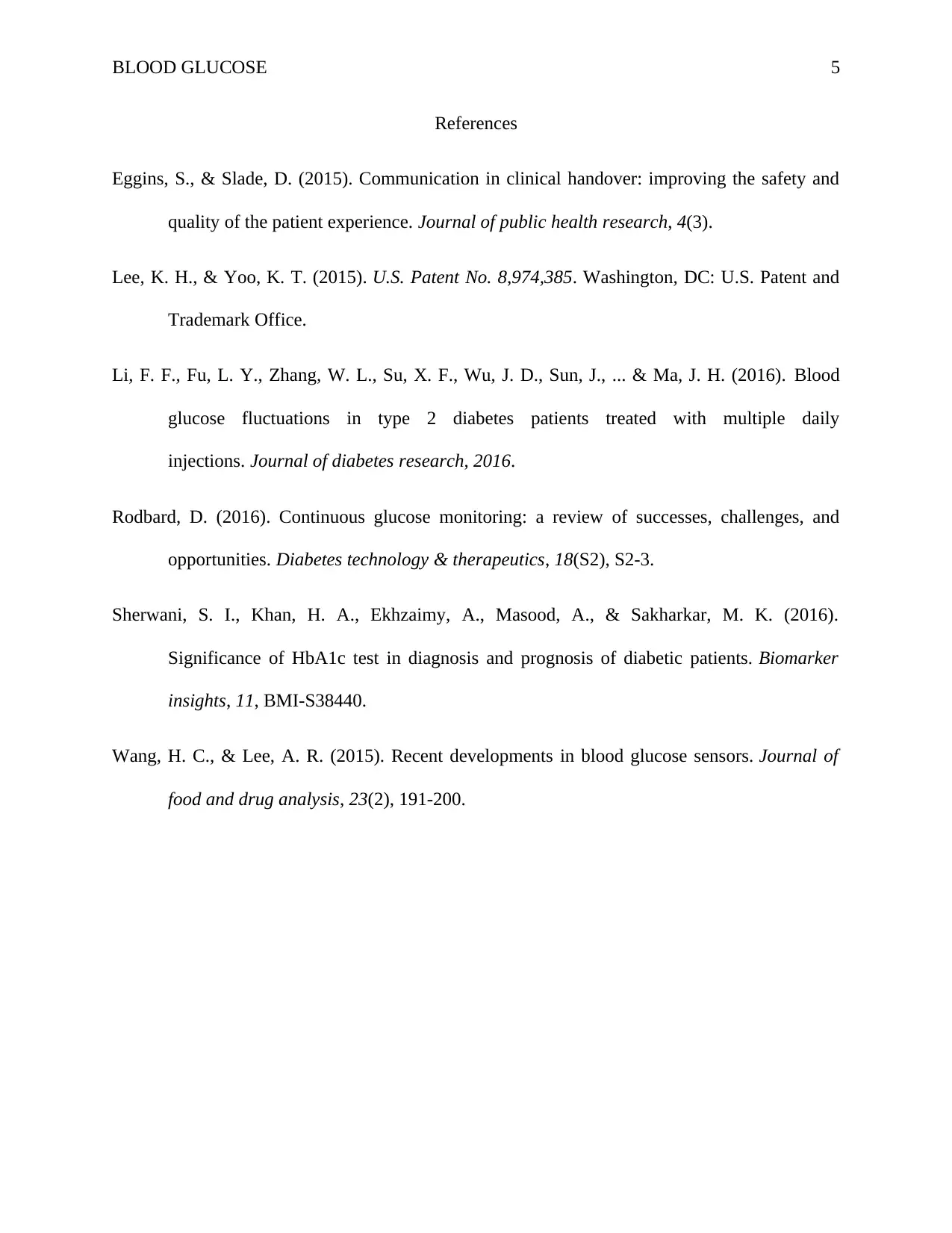
BLOOD GLUCOSE 5
References
Eggins, S., & Slade, D. (2015). Communication in clinical handover: improving the safety and
quality of the patient experience. Journal of public health research, 4(3).
Lee, K. H., & Yoo, K. T. (2015). U.S. Patent No. 8,974,385. Washington, DC: U.S. Patent and
Trademark Office.
Li, F. F., Fu, L. Y., Zhang, W. L., Su, X. F., Wu, J. D., Sun, J., ... & Ma, J. H. (2016). Blood
glucose fluctuations in type 2 diabetes patients treated with multiple daily
injections. Journal of diabetes research, 2016.
Rodbard, D. (2016). Continuous glucose monitoring: a review of successes, challenges, and
opportunities. Diabetes technology & therapeutics, 18(S2), S2-3.
Sherwani, S. I., Khan, H. A., Ekhzaimy, A., Masood, A., & Sakharkar, M. K. (2016).
Significance of HbA1c test in diagnosis and prognosis of diabetic patients. Biomarker
insights, 11, BMI-S38440.
Wang, H. C., & Lee, A. R. (2015). Recent developments in blood glucose sensors. Journal of
food and drug analysis, 23(2), 191-200.
References
Eggins, S., & Slade, D. (2015). Communication in clinical handover: improving the safety and
quality of the patient experience. Journal of public health research, 4(3).
Lee, K. H., & Yoo, K. T. (2015). U.S. Patent No. 8,974,385. Washington, DC: U.S. Patent and
Trademark Office.
Li, F. F., Fu, L. Y., Zhang, W. L., Su, X. F., Wu, J. D., Sun, J., ... & Ma, J. H. (2016). Blood
glucose fluctuations in type 2 diabetes patients treated with multiple daily
injections. Journal of diabetes research, 2016.
Rodbard, D. (2016). Continuous glucose monitoring: a review of successes, challenges, and
opportunities. Diabetes technology & therapeutics, 18(S2), S2-3.
Sherwani, S. I., Khan, H. A., Ekhzaimy, A., Masood, A., & Sakharkar, M. K. (2016).
Significance of HbA1c test in diagnosis and prognosis of diabetic patients. Biomarker
insights, 11, BMI-S38440.
Wang, H. C., & Lee, A. R. (2015). Recent developments in blood glucose sensors. Journal of
food and drug analysis, 23(2), 191-200.
1 out of 5
Related Documents
Your All-in-One AI-Powered Toolkit for Academic Success.
+13062052269
info@desklib.com
Available 24*7 on WhatsApp / Email
![[object Object]](/_next/static/media/star-bottom.7253800d.svg)
Unlock your academic potential
Copyright © 2020–2025 A2Z Services. All Rights Reserved. Developed and managed by ZUCOL.





